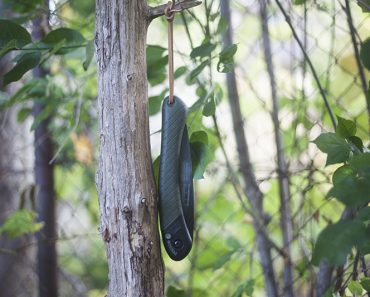Getting caught out in deep snow can be deadly. Not only is there the risk of hypothermia, but even moving around in the snow can be difficult. If you’re strong enough to push through snow that’s up to your waist, you still have the risk of your exertion melting the snow up close to your legs and making your clothing wet. Those wet cotton blue-jeans can make you lose your body heat hundreds of times faster than if you were standing their naked.
The answer to this age-old question is to stay out of the snow, either by only walking where there is no snow or by staying on top of it. That’s where snowshoes come in. A good pair of snowshoes is invaluable in such a situation, allowing you to travel easily and stay above the snow while doing so. Granted, walking in a pair of snowshoes is much more difficult than walking on the pavement; but it’s much, much easier than walking through deep snow.
So, all you need to do is fit a pair of snowshoes into your survival kit and you’re ready to go, right? Uh, that’s a bit unrealistic. Snowshoes run from 20 to 36 inches long and the heavier you are, the longer you need them to be. That’s a bit difficult to fit into any bug out bag, let alone a survival kit. I suppose you could carry a set in your bug out vehicle; but if you’re in that vehicle, why would you need snowshoes?
No, when you’re going to need such gear is when you’re stuck on foot, out in the wilderness, not having expected Mother Nature to dump a couple of feet of snow on you overnight. I’ve been in such a situation and things go from “Isn’t the snow beautiful” to life-threatening in a hurry. Finding someplace to hide out and wait out the storm is one thing; but getting out, afterwards, is something else entirely. The snow hampers your ability to make your way back to civilization, hides trails and roads, and even makes it harder for rescuers to come find you.
That means effecting a self-rescue and to do that you’ll need some way of walking through, or better yet on top of, the snow. In other words, you’ll need snowshoes. Since it’s unlikely that you’re going to be brining them in with you, you’ll need to make them from materials that you have available to you in the woods.
How Snowshoes Work
Before talking about how to make survival snowshoes, it would help us to have an understanding of just how they work. There’s really nothing all that special about snowshoes, other than the fact that they help us to walk on the snow’s surface, rather than sinking in. They do that by spreading our weight over a larger surface area.
One of the challenges for making any snowshoes is keeping the weight down. Not that it would be available out in the middle of the woods, but if we were to make snowshoes out of ¾” plywood, the weight of the plywood would make it extremely hard to move about for long in them.
Traditionally, snowshoes were made out of a web woven from rawhide. While that left holes between the strands of rawhide, the surface tension of the snow was such that the snowshoe would stay on top of the snow. Modern snowshoes use lightweight plastics or fabric, such as rip-stop nylon. In any of those cases, the snowshoes are light, while still being able to support a full-grown man with a heavy pack.
Making Frames for Survival Snowshoes
Any snowshoe consists of a frame, decking of some sort, and some means of attaching the snowshoes to the user’s boots, generally straps of some sort. For our purposes, the straps are the easiest part, as we can use paracord to tie the snowshoes to our boots.
The one thing we have to have with us, if we are going to make survival snowshoes, is some sort of cordage, such as paracord. Fortunately, that’s something that we all carry in our bug out bags and survival kits. If you only have 100 feet of paracord in your kit, I’d recommend doubling that, at least. You’ll also need a knife and a saw would be useful; but then, those are also things we carry.
For the frame, we need to cut saplings from the forest around us. You don’t want anything that’s very wide, but you’ll need about 6 to 7 feet of good wood to make the frames. Cut more than you’ll need, just in case they don’t work out well. Since it will be wintertime, these saplings will be harder and less green than they would be in the summertime, as the sap will have gone down into the roots. They still shouldn’t be all that hard to cut, but they may be a bit difficult to bend.
Speaking of bending the saplings, it might be necessary to thin the thick end down, in order to make it more flexible. This is normal whittling work and shouldn’t cause anyone a problem. Carrying a honing stone in your survival kit and bug out bag make it easy to sharpen your knife for such emergency projects.
In order to bend your saplings to make frames out of them, some help may be necessary. Before you start whittling, place a large, round rock (10 – 14 inches in diameter) in your fire, allowing it to heat up. Heat is a common way of bending wood, in the manufacture of musical instruments and recurving the ends of bows. The only place you’ll need that for your snowshoes, is the middle of the shoe, what becomes the toe. Using heat will allow a tighter curve, with the shoe hopefully ending up the diameter of the stone.
The tail ends of the saplings will need to be tied together, making the heel of the snowshoe. While it is still subtle enough to bend, tie a couple of cross-braces in the middle of each, spaced so that they will support the ball of your foot and the heel. These will ultimately control how wide your snowshoes are, so cut them accordingly. Ideally, you want 10 to 12 inches.
Making the Snow Shoe Deck
Normally, the time-consuming part of making a pair of snowshoes is weaving the deck. Holes are drilled through the frame for the rawhide to go through, ensuring that the webbing stays in place, even when wet. Those holes are still going to be necessary, but can be burned through the frame with a sharp awl or pick that’s heated in the fire. Ideally, they should be 1” to 1-1/2” apart; but you will probably have to make them further apart, unless you have a lot of paracord.
What should you do if you don’t have enough paracord? In that case, you’ll have to use whatever cordage you have on-hand. Plastic cordage, cut from bottles will work, although it will be harder to work with. Leather thongs will work as well, even if it is uncured leather. Remember, you’re in survival mode. You can even take cloth and tear it into strips; although it would probably be better to use the cloth intact, spanning the area with it and tying it to the frame.
Another option is to use a combination of cordage and tree bark, assuming you can find trees with a thin, lightweight and flexible bark that you can peel off in sheets. That will depend a lot on the part of the country you’re in. If you can find it, cut pieces of tree bark and use your available cordage to tie it to the frame. Make holes in the bark, for tying it, the same way as you make the holes in the frame.
You’re going to weave the netting for each snowshoe in three sections: the toe, which is forward of the crossbar supporting the ball of your foot; the heel, which is behind the second crossbar; and the center section. Weaving is normally done as a combination of diagonal and straight lines, making a roughly hexagonal design. For our purposes here though, the design is immaterial, just as long as you create a webbing. I’d go for a square pattern on a 45-degree angle.
The final part is tying the snowshoes to your boots. Tie the toe to the front cross-brace with paracord and then make a loop going form that cross-brace around the back of the boot’s heel. Don’t tie the heel of your boot down, as you need the flexibility of it rising off the snowshoe’s deck, in order to be able to walk easily.
One Final Thought
Walking with snowshoes can be challenging, if you’ve never done it before. While it doesn’t really take all that long to develop the balance and stride to cover ground with them, when you first try, there’s a good chance you’ll fall. To help prevent this, take a couple of your leftover saplings and make something like ski poles out of them, adding a “basket” down at snow-top level, so that they don’t sink far into the snow.




























